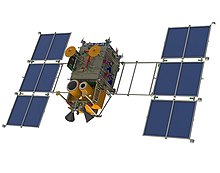
Summary
Kanopus-V-IK (formerly Kanopus-V 2[2]) is a Russian Earth observation satellite developed by the All-Russian Scientific Research Institute of Electromechanics and operated by Roscosmos. It was launched on July 14, 2017, designed for monitoring the environment over a large swath of land, and has an expected service life of 5 years.
 Illustration of the Kanopus spacecraft | |
| Names | Kanopus-V 2 |
|---|---|
| Mission type | Earth observation |
| Operator | Roscosmos Roshydromet[1] |
| COSPAR ID | 2017-042A[2] |
| SATCAT no. | 42825[3] |
| Mission duration | 5 years (planned) 6 years, 8 months and 28 days (elapsed) |
| Spacecraft properties | |
| Bus | Kanopus |
| Manufacturer | NPO VNIIEM |
| Launch mass | ~600 kg (1,300 lb) |
| Power | 300W |
| Start of mission | |
| Launch date | July 14, 2017 12:36 West Kazakhstan Time (06:36 UTC)[1] |
| Rocket | Soyuz-2 |
| Launch site | Baikonur Cosmodrome Site 31 |
| Orbital parameters | |
| Reference system | Geocentric |
| Regime | Low Earth |
| Semi-major axis | 6,884 km (4,278 mi) |
| Periapsis altitude | 512.7 km (318.6 mi) |
| Apoapsis altitude | 515.2 km (320.1 mi) |
| Inclination | 97.4° |
| Period | 94.8 minutes |
| Instruments | |
| Panchromatic Imaging System, Multispectral Imaging System, Multispectral Scanner Unit-IK-SR[4] | |
Design edit
Kanopus-V-IK's mission is to collect data for environmental monitoring and mapping, detection of fires, agricultural planning, and assessing land use. It can also be used to monitor man-made and natural disasters.[4][5] The satellite uses the Kanopus satellite bus. It was originally built as Kanopus-V 2 but was modified to include an infrared detection capability.[2]
Kanopus-V-IK contains several instruments. The Panchromatic Imaging System (PSS) collects black-and-white images for monitoring the environment and covers a ground swath of 23.3 km (14.5 mi). The Multispectral Imaging System (MSS) covers four spectral bands. The green wavelengths are used for vegetation monitoring and the red to near-infrared wavelengths for fire and hotspot detection. The Multispectral Scanner Unit-IK-SR (MSU-IK-SRM) aids in fire detection over a 2,000 km (1,200 mi) swath of the Earth's surface, while having a minimal revisit time due to the satellite's low orbit.[4][5]
Launch edit
Kanopus-V-IK launched from Baikonur Cosmodrome Site 31 on July 14, 2017, at 12:36 local time (06:36 UTC) on board a Soyuz 2 rocket. It was launched with over 70 other satellites in a satellite rideshare mission. It contained 48 CubeSats for Planet Labs.[1][6] They were launched to a low Earth orbit with a perigee of 512.7 km (318.6 mi), an apogee of 515.2 km (320.1 mi), and an inclination of 97.4°.[3]
References edit
- ^ a b c Graham, William (2017-07-14). "Soyuz 2-1A launches with Kanopus-V-IK and over 70 satellites". NASASpaceFlight.com. Archived from the original on 2020-11-09. Retrieved 2021-12-13.
- ^ a b c "Kanopus-V-IK 1". Gunter's Space Page. Archived from the original on 2021-10-27. Retrieved 2021-12-13.
- ^ a b "Technical details for satellite KANOPUS-V-IK". N2YO.com - Real Time Satellite Tracking and Predictions. Archived from the original on 2021-04-21. Retrieved 2021-12-13.
- ^ a b c "Kanopus-V-IK 1 - eoPortal Directory - Satellite Missions". directory.eoportal.org. Archived from the original on 2021-10-22. Retrieved 2021-12-13.
- ^ a b "Kanopus V-IK – Soyuz – 73 Satellites". spaceflight101.com. 9 August 2017. Archived from the original on 2021-04-19. Retrieved 2021-12-13.
- ^ Clark, Stephen. "Soyuz rocket lifts off with 73 satellites – Spaceflight Now". Archived from the original on 2021-11-11. Retrieved 2021-12-13.


